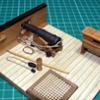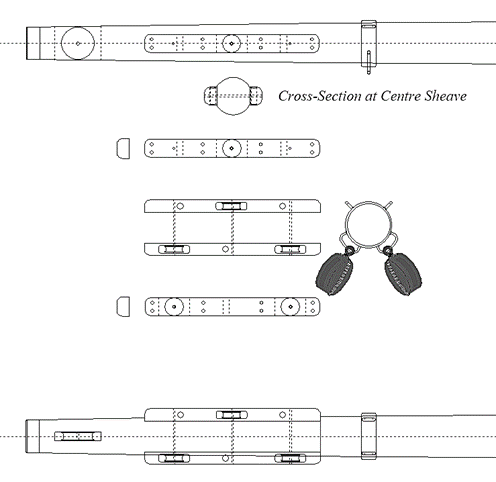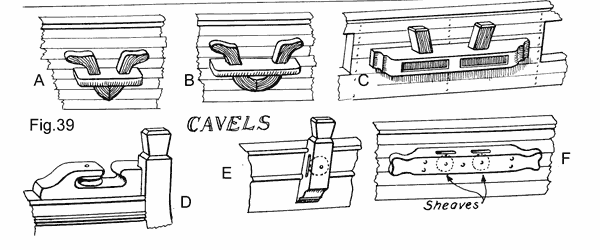-
Posts
5,918 -
Joined
-
Last visited
Content Type
Profiles
Forums
Gallery
Events
Everything posted by BANYAN
-
Great to see you complete her, she looks great - congratulations! You should be proud of your efforts as you have come a long way in your build techniques etc. cheer Pat
-

HMCSS Victoria 1855 by BANYAN - 1:72
BANYAN replied to BANYAN's topic in - Build logs for subjects built 1851 - 1900
I couldn't agree more Eberhardt and Steven. My plan was to simply put in some notches (about 0.75mm long) and the holes at 0.5mm, hoping the squared longer holes/slots would look the part - well that is the plan at the moment. I am just about to experiment with the same wood (Ballarat Pear) I have used for the boom and jaws hoping it will hold the defined squared slot shape. Thanks for the wishes Steven. I have been doing some work in the background experimenting with the spiderbands, boom saddles etc and think I have resolved my way ahead with those fittings. cheers Pat- 993 replies
-
- gun dispatch vessel
- victoria
-
(and 2 more)
Tagged with:
-
The 'skeleton' framing is coming on very nicely Steven. Looks great. cheers Pat
- 508 replies
-
Wow! that looks great Glen. The level of detail at this scale is amazing - you continue to impress (even though you ignore our calls for seagull poo etc says I quietly - sorry don't want the penguins to hear) cheers Pat
- 290 replies
-
- Quinquereme
- Finished
-
(and 1 more)
Tagged with:
-

HMCSS Victoria 1855 by BANYAN - 1:72
BANYAN replied to BANYAN's topic in - Build logs for subjects built 1851 - 1900
Hi folks, sorry I have gone a little quiet again in this log but I have been doing a little further research to allow me to complete the booms. I had to determine what the odd conformal shapes were on the booms near the outer end. This also led me to determining I had positioned the spiderbands at the wrong point. I had believed they were positioned at the GD (given diameter) when in fact they were further out in Victoria - this has led to me having to remake the spiderbands I have still to do the new ones, but practice makes perfect they say. I am also trying to determine how to make the reefing combs (those conformal fittings I referred to earlier) - see the attached. At 1:72 these are only 1.5mm deep so a little fiddly to make - still thinking on the 'how' for now. These were used to rig the reefing pendants. One end was led through the hole opposite it associated sheave and stoppered with a knot, the pendant was then rove through it associated reefing cringle and down through the sheave. The tail was then worked with a reefing tackle as required when reefing the fore-and-aft sail. The attached is my CAD drawing of the outer end of the main boom. It shows the combs and the spiderband, and the outer sheave. There is also an iron band on the very end/tip of the boom. cheers Pat- 993 replies
-
- gun dispatch vessel
- victoria
-
(and 2 more)
Tagged with:
-

Danny Vadas' masting and rigging spread sheet
BANYAN replied to allanyed's topic in Masting, rigging and sails
Hi Allan, I think this is probably Microsoft trying to fix/patch some of their security issues by restricting some macro operations. I remember some time back I had to load and keep using flash or the like to keep older macros active., but MS doesn't like that either. I know I am having issues trying to use macros I created for use in MS Word. I just opened a version of the spreadsheet using Excell (using the latest version of Excel in MS 360) that I had downloaded years ago and there was no issue. I haven't tried opening from the Database yet. cheers Pat -
That is a very interesting point you make. I will need to reconsider this, but I may be missing a point you are making here. When designing this ship, Oliver Lang did not conform with the old/traditional methods of building a ship; he was of the new generation (not the Guild I believe - his father certainly was). For example, for the Victoria he used diagonal planking (to his plan which was based on a system he developed from a Devonport boat builder), he also used an Aberdeen style (clipper) bow, and a non-lifting screw design (first fit of this 'differential screw' design by Maudslay, fitted in any warship). The hull skeleton, especially aft, I think may have been quite different to the traditional more squared and spaced framing. Desmond, and also ESTEP (1918), describe the building of "Wooden Ships" and, if I recall correctly, do sometimes refer back (within their text) to pre-turn-of-the-century techniques, and their descriptions do not appear to refer to the use of iron and timber in composite form for the stern timbers (that I have found so far at least). I have not read them extensively yet, but I have not seen any reference to composite, rather than wooden building technique? All that said, I only raise these points to gain a better understanding, and you are probably right. I just need to get a better understanding of the points you make to establish whether to use these authors or not. Certainly, Oliver Lang in designing this one-of-a-kind vessel, used it as an opportunity to show the Admiralty some alternative building principles. Victoria was certainly unique for her time, and while she looked, and was armed, similar to contemporary Gun Despatch vessels (Arrow and Vigilance Class) she was framed/built on an entirely different principle that made extensive use of iron knees, hangers, etc, but she was not a composite build. She was also equipped with many different equipment designs such that I am at a loss to try and even make an educated guess of how her stern timbers were arranged and fixed. From the imagery, and the Builder's Certificate, she certainly had an elliptical stern and the knuckle line also appears more rounded than the traditionally framed sterns. cheers Pat
-
Allan, thanks for the suggestion. Unfortunately, if scantlings are given in that Contract, that class of ship was built on different principles to Victoria. I have the Contract and appended Specification for HMCSS Victoria, but unfortunately, the scantlings given only cover the floors, bent timbers and roughtree timbers. There is absolutely nothing WRT the stem and stern (nor the cant) timbers (or the deck beams unfortunately) - hence my questions here. With no experience in drawing/lofting of ship framing, and finding nothing online nor in any book about the stern framing used in diagonally planked ships, it is doing my head in . The best/fullest description for these timbers I have found to date are in "Wooden Shipbuilding" by Charles Desmond (1919). PDF copies can be found online); but even here the subject is not fully covered. At this point, I think I will use the stern timber framing shown for British ships of this era supplemented with Desmond's descriptions, then modify all but the most aft of the after cant timbers that may lie forward of 30feet from the sternpost. the reason for this is that Commander Lockyer (Build Superintendent) in one of his reports to the Governor of Victoria (Hotham) states that about 30 feet forward and aft of the keel was put down along with the shadow moulds, but that the remainder of the keel would not go on until the diagonal planking had been completed. cheers Pat
-
Thanks all, that is exactly the type of thing I am looking for. Much appreciate the feedback and great info. My real issue now is trying to interpret how the after-cant timbers will have differed as Victoria was built using Diagonal planking (to Oliver Lang's plan) whereby most of the frames (floors IAW the Contract) ended at the round of the hull. The usual frames were replaced with 'bent timbers' which replaced the temporary 'moulds'. These were placed midway between the floor timbers from the round to the gunwhale. When the side planking was put on, the first and second diagonals were actually wrapped under the hull and went up the other side, and the keel (except for 30 feet of it both forward, and aft) was put on after the diagonals and then the outer horizontal layer of planking put on in a more traditional manner once the bent and roughtree timbers had been put in. From what I can see, I believe I would need at least a 'full' aftermost cant-timber in-situ for the stern timbers to butt onto? Quite the puzzle for this model builder to get his head around cheers Pat
-
Hi all, I am trying to find some good examples of the timbers (fashion pieces, transoms etc) that would form a typical elliptical stern for a vessel c1855. I have looked through the NMM files (as best I can) for something that might be suited but have lucked out so far. I have also done a quick look (not yet complete) in the Danish Digital Library (Museum) and found a contemporary ship the Jylland, but she has a different arrangement. I have plans for the British Gun Despatch Vessels (Arrow Class 1854) and Vigilance Class (1856) but the plans do not show the framing or timbers. I would appreciate any pointers or suggestions that would allow me to create the framing/timbers used in such a vessel to allow me to draw up the 'probable' stern for HMCSS Victoria (1855). cheers Pat
-
I've never even seen a dado stack (blades) for that sized table Bruce - it will be interesting to see if anyone has. I typically use my router for these tasks - putting a sacrificial piece of wood behind the piece being cut/routed protects it from chip-out keeping it all nice and clean looking. I like your solution though, seems to work well. cheers Pat
-
Hi Steven, these could be the upper ends of the rising timbers but might also be the tops of cavels or the like - see attached which is from 'The Neophyte Ship Modeller's Jackstay'. Also, I agree these appear to be 'something' formed in loops as they appear to be draped over the timber tops rather than as a ring attached/fitted to the hull proper. Whether they are rope though I am not sure, as this is an unusual way to depict rope. cheers Pat
- 508 replies
-
No matter what the reason, great to see you back mate. I hope the recovery goes well. The revised stand looks good. cheers Pat
-
Wow that is some nice work 👋. I hope it all works for you, but I am sure testing may highlight a few small improvements or fixes to be made. She sure will look a 'picture' on the pond/pool. cheers Pat
- 536 replies
-
- Quadrireme
- radio
-
(and 1 more)
Tagged with:
-
Very nice work on such a delicate skeletal frame Steven. Not surprising you had to make a few corrections, but it all looks symmetrical and starting to look a little more robust. cheers Pat
- 508 replies
-
You're making some great progress there Steven. The 'skeletal' framework looks very delicate, so I hope the fitting of the clamps, breast kooks etc stiffen this up sufficiently for you when working the planking etc. cheers Pat
- 508 replies
-
Hi Glen, sorry have not commented much as I have been down and out with a flu of late - just getting back onto the horse so to speak. That is an incredibly well detailed miniature which will make into a very fine diorama; everything appears very nicely to scale. cheers Pat
- 290 replies
-
- Quinquereme
- Finished
-
(and 1 more)
Tagged with:
-
I think this is a case of 'horses for courses'. I find that the more pre-rigging of the tops and yards you do the easier you make it on yourself later - BUT some of these lines will need to be coiled and kept out of the way. More importantly, you need to be somewhat selective on which lines you pre-rig. This will depend on the ship (type of rigging specifically) as some lines will simply get in the way if pre-rigged. So, as with my "Endeavour" build in particular, I had to go through the rigging well in advance to see what would be beneficial, but still not obstruct, the fitting of the yards and other rigging, by pre-rigging some lines beforehand. With some blocks I elected to set-up a small length of leader line (small) that I could pull the actual line through when needed rather than pre-rig the entire line. All that said, if I recall this still only accounted for a small number of lines as clearance was required to do the rat lines etc before rigging some of these lines. So essentially; your call after some analysis of which of these lines would or not interfere with other rigging processes such as doing the rattlin. cheers Pat
-
Some of the greatest inventions were found by 'accident' Glen Nice work mate. cheers Pat
- 290 replies
-
- Quinquereme
- Finished
-
(and 1 more)
Tagged with:
About us
Modelshipworld - Advancing Ship Modeling through Research
SSL Secured
Your security is important for us so this Website is SSL-Secured
NRG Mailing Address
Nautical Research Guild
237 South Lincoln Street
Westmont IL, 60559-1917
Model Ship World ® and the MSW logo are Registered Trademarks, and belong to the Nautical Research Guild (United States Patent and Trademark Office: No. 6,929,264 & No. 6,929,274, registered Dec. 20, 2022)
Helpful Links
About the NRG
If you enjoy building ship models that are historically accurate as well as beautiful, then The Nautical Research Guild (NRG) is just right for you.
The Guild is a non-profit educational organization whose mission is to “Advance Ship Modeling Through Research”. We provide support to our members in their efforts to raise the quality of their model ships.
The Nautical Research Guild has published our world-renowned quarterly magazine, The Nautical Research Journal, since 1955. The pages of the Journal are full of articles by accomplished ship modelers who show you how they create those exquisite details on their models, and by maritime historians who show you the correct details to build. The Journal is available in both print and digital editions. Go to the NRG web site (www.thenrg.org) to download a complimentary digital copy of the Journal. The NRG also publishes plan sets, books and compilations of back issues of the Journal and the former Ships in Scale and Model Ship Builder magazines.






